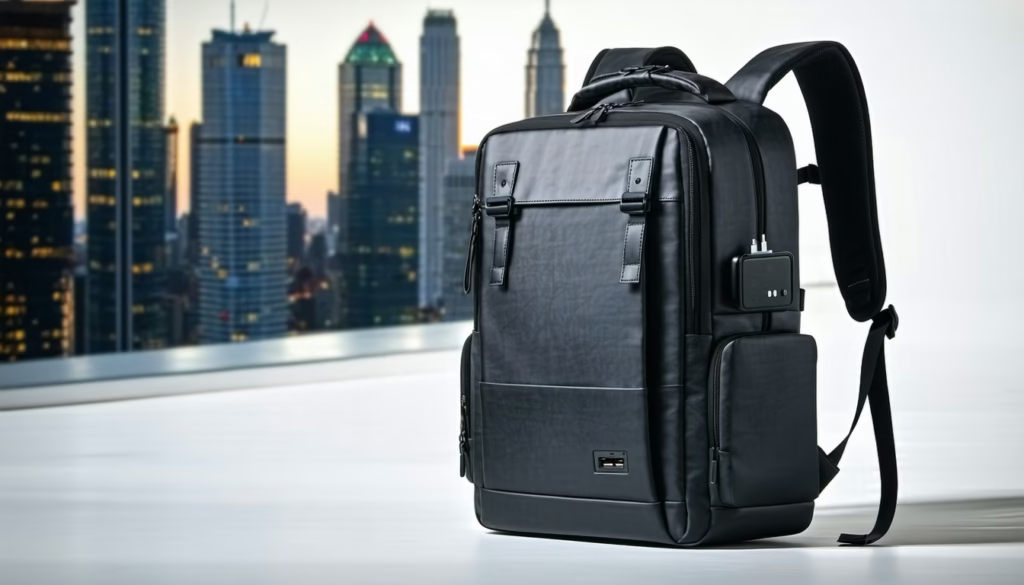Essential Tech Gadgets That Fit Perfectly In A Weekender Backpack

Picture this: we’re at the airport, about to board, and we realize our charger is buried under a stack of T-shirts. We’ve been there. When you’re limited to a single piece of luggage, dialing in tech in weekender backpack setups is key. Over the years, we’ve tested dozens of tiny tools to find gadgets that save space but deliver big performance. In this guide, we’ll share the critical electronics, power solutions, and security gear we never leave home without. By the end, you’ll know exactly what to pack, how to protect it, and how to keep everything powered up for a stress-free weekend trip.
Selecting a Weekender Backpack
As much as we love our gadgets, the right bag makes all the difference. A weekender backpack should fit your tech, clothing, and a splash of toiletries without bulking you up. Here’s how we zero in on the perfect carryall.
Matching Bag Size To Needs
First, think about your travel style. If you’re hopping flights and avoiding checked luggage, opt for a carry-on weekender that meets airline limits. Aim for 20–30 liters of volume—enough for a laptop, a camera, plus a change of clothes. Sketch out your typical loadout: phone, tablet, power bank, cables. That rough count helps you nail the ideal volume before you start browsing.
Checking Bag Features
Next, inspect pockets and access points. We look for a wide top opening so we can grab our camera or earbuds without emptying the whole bag. A wide opening weekender style is a game-changer. Built-in USB ports and pass-through charging cables let us juice up on the go—consider a USB weekender backpack if that’s crucial. Don’t forget water resistance: a weather-resistant weekender backpack finish protects electronics when spring showers catch you off-guard.
Considering Weight and Material
Heavy leather might look great, but it adds unnecessary kilos once gadgets are inside. We gravitate toward lightweight weekender backpack designs in durable nylon or canvas. For eco-minded travelers, an eco-friendly weekender backpack made from recycled fabrics feels good and trims weight. And if you can’t decide, compare canvas vs leather vs nylon backpack pros and cons to pick your favorite.
Choosing Convertible Styles
Finally, think versatility. Some designs switch from tote to backpack, or unzip for extra space—see our take on the expandable weekender backpack. If you’re hopping from work calls to weekend hikes, a convertible weekender backpack can handle both without requiring a swap.
Organizing Your Tech Gear
Once the bag’s sorted, we focus on keeping everything neat and accessible. A tangled mess of cords or loose adapters can cost precious minutes when you need to top up your devices.
Using Compartments and Pouches
Most weekender packs include a laptop sleeve or a zippered front pocket. Slot your tablet or e-reader in the padded section, then stash smaller items—like power bricks, SD cards, or charging cables—in dedicated pouches. We like slim neoprene pouches that cushion against bumps without adding bulk.
Packing Cubes for Electronics
Packing cubes aren’t just for clothes. A small cube dedicated to tech can hold your power bank, spare cables, and battery packs all in one spot. Try a label or color-code your cube for “power” so you don’t have to riffle through every pouch. For more on packing cubes, check our guide on packing cubes in backpack.
Labeling Cables and Accessories
A simple label—like colored tape or a tiny sticker—on each cable helps us identify USB-C, Lightning, and micro-USB at a glance. Wrapping cables with reusable velcro straps prevents knots and gives a satisfying click when you stow them away. We always keep at least one spare charging cable stashed in our tech cube.
Power and Charging Essentials
Running out of juice is a travel nightmare. Here are the tools we rely on to keep our phones, cameras, and laptops powered throughout a weekend away.
Portable Power Banks
A high-capacity power bank is nonnegotiable. We usually carry a 20,000 mAh model—it balances capacity and weight so you can charge a phone four times or give your tablet a top-off. If you need something lighter, a 10,000 mAh pack weighs around 200 grams and still covers a full smartphone charge.
| Capacity (mAh) | Weight Approx. | Device Charges |
|---|---|---|
| 10,000 | ~200 g | 2–3 smartphone charges |
| 20,000 | ~350 g | 4–5 smartphone or 1 tablet charge |
| 26,800 | ~450 g | Multiple devices across the weekend |
Universal Chargers and Adapters
We love a compact charger with at least two USB-C ports and one USB-A port. That way, we can power our phone and computer side by side. If you’re flying internationally, pack a set of plug adapters—it takes up barely any room. Some chargers even collapse flat for easy stashing.
Cable Management Tools
To keep everything orderly, we use a fold-out cable organizer. It holds four cables plus a couple of memory cards. Velcro straps or silicone cable ties keep each lead wrapped neatly. When one device runs low, we just unzip the organizer and grab what we need—no digging required.
For a seamless charging setup, we pair our power bank with a lightweight weekender backpack charger mount. It clips onto an interior loop, so we can charge while we roam.
Staying Connected On the Move
Reliable internet and location tracking make a weekend trip smoother. Here’s how we avoid dead zones and lost luggage.
Mobile Hotspots and Data Plans
Rather than hunting for Wi-Fi, we pack a pocket-sized hotspot with its own data plan. It gives us secure, fast access to email and maps. If you’re crossing borders, pick a provider with a global SIM or consider an eSIM service you can top up on the fly.
Bluetooth Trackers
Losing keys is one thing—misplacing a pricey camera or laptop is a different story. We slip a slim Bluetooth tracker into our tech pouch and pair it with our phone. A quick ping shows the last known location. Some models even alert us if we wander too far.
All-in-One Hubs
For us, a multiport hub is a lifesaver in hotel rooms or coworking spaces. One USB-C input, two USB-A ports, plus HDMI output and an SD card reader means we can connect everything without carrying a stack of adapters. It’s like having a mini docking station in your bag.
Audio and Entertainment Devices
Whether you’re off to the beach or a boardroom, entertainment tech keeps us happy on layovers or downtime.
Travel-Ready Earbuds
Earbuds with active noise cancellation help us tune out airport chatter or enjoy music on a train. We pick models with a compact charging case that fits in an interior pocket. Look for water-resistant ratings if you plan to sweat it out at the gym before your flight.
Compact Portable Speakers
A tiny Bluetooth speaker can transform a hotel room into your personal concert hall. Seek one that floats if you’re a poolside reader, and weighs under 300 grams so it doesn’t tip the scales. Some even come with carabiner clips for attaching to your backpack strap.
E-Readers and Tablets
An e-reader is lighter than lugging hardcover books—ideal for packing into a wide-opening weekender pocket. If you need more versatility, a tablet covers reading, streaming, and video calls. We stow them in a padded sleeve inside the main compartment.
Protecting Your Devices
Your gadgets deserve just as much care as your outfits. Here’s how we shield our tech from drops, spills, and scratches.
Tech Organizing Cases
A form-fitting hardshell case is perfect for cameras and lenses. It snaps shut to keep things in place, and most fit neatly inside a side pocket. Carrying your accessories separately also stops the main compartment from turning into a jumble.
Shockproof Sleeves
For laptops and tablets, we choose neoprene or foam sleeves with extra padding at the corners. They slide into the backpack’s laptop compartment, then slip in and out in seconds. Think of them as a hug for your screen.
Weather-Resistant Solutions
Rainstorms and coffee spills can strike without warning. A waterproof pouch or ziplock bag inside the main chamber can save a soaked tablet. For an all-in-one approach, some brands offer a weather-resistant weekender backpack that seals out moisture entirely.
Smart Security Accessories
We like tech that keeps our gear—and ourselves—safe while we explore.
RFID-Blocking Wallets and Holders
Credit cards and passports with RFID chips can be skimmed in crowded places. An RFID-blocking sleeve or wallet blocks unwanted scans. It’s thin enough to slide into the same pouch we use for charging cables.
Smart Luggage Tags
A GPS-enabled luggage tag attaches to backpack handles. If your bag gets misplaced, you can track its last location on your phone. It’s a small investment compared to the cost of replacing your gear.
Portable Door Alarms
In a sketchy rental or hostel, a tiny door alarm gives extra peace of mind. It fits in your tech pouch and installs on any door with a latch. If someone tries to open it, the alarm blares—and we can keep gadgets and luggage right where we left them.
Tech Maintenance Tips
A little upkeep extends the life of every gadget we carry. These quick habits take only minutes but pay off on the road.
Cleaning Your Gear
Electronics pick up dust and grime fast—especially in airports and train stations. We carry a microfiber cloth and a can of compressed air to dust out crevices. For our weekender itself, we follow tips for cleaning a weekender backpack to keep the interior fresh.
Preserving Battery Health
We avoid letting batteries drain completely. Topping off devices at 20–30 percent extends overall lifespan. When storing power banks between trips, we aim for around 50 percent charge to prevent deep-discharge damage.
Updating Software
Before a trip, we set aside time to update device firmware and apps. That cuts down on security risks, ensures reliability, and often unlocks new features—like better power management or improved Bluetooth stability.
Frequently Asked Questions
-
What Are the Must-Have Tech Gadgets for a Weekend Trip?
We never travel without a reliable power bank, universal charger, high-capacity braided cables, compact earbuds, and a slim hotspot device. -
How Do I Keep My Cables from Tangling?
Use reusable velcro or silicone cable ties, and store cords in a fold-out organizer or small pouch marked “cables.” -
Can I Bring a Power Bank on a Plane?
Yes, most airlines allow power banks under 100 Wh in carry-on luggage. Always check your carrier’s rules before you fly. -
What Capacity Power Bank Should I Choose?
For a weekend, we recommend 20,000 mAh. It weighs about 350 g and can recharge a phone multiple times or top off a tablet. -
Do I Need a Mobile Hotspot or Is My Phone Enough?
If you depend on secure, fast internet—especially abroad—a dedicated hotspot with its own data plan is more reliable than tethering to your phone. -
How Can I Protect My Gadgets from Water and Bumps?
Invest in shockproof sleeves for laptops and tablets, a hardshell camera case, and small waterproof pouches for smaller electronics. -
Are Earbuds Better Than Over-Ear Headphones for Travel?
Earbuds win on space and weight, while over-ear models offer superior noise cancellation and comfort on long flights. Pick based on your priorities. -
How Often Should I Update Device Software Before Travel?
Aim to update at least once a week if you travel frequently. That way you avoid last-minute patches and potential security gaps.
Conclusion
Packing the right tech for a weekend getaway doesn’t have to be a puzzle. With a thoughtfully chosen weekender backpack, smart organizing strategies, and a compact set of power and security essentials, we can travel lighter, stay connected, and keep our devices safe. Give one of these tips a try on your next trip—your future self will thank you.
Happy travels and smooth charging!


